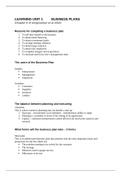LEARNING UNIT 1 BUSINESS PLANS
(Chapter 6 of Longenecker et al 2014)
Reasons for compiling a business plan
1. To sell him/ herself to the business
2. To obtain bank financing
3. To obtain investment funds
4. To arrange strategic alliances
5. To obtain large contracts
6. To attract key employees
7. To complete mergers and acquisitions
8. To motivate and focus one’s management team
The users of the Business Plan
Insiders
Entrepreneur
Management
Employees
Outsiders
Customers
Suppliers
Investors
Lenders
The balance between planning and executing
3 benefits
This is where extensive planning may not benefit a start up
1. Start-ups – environment is too turbulent – entrepreneurs ability to adapt
2. Planning is a problem in terms of the timing of an opportunity
3. Capital – constraint entrepreneurs cannot afford to do much prior analysis and
research.
What forms will the business plan take – 2 forms
Short plan
This is an abbreviated business plan that presents only the most important issues and
projections for the bus which are:
The problem needing to be solved for the customer
The strategy
Measures used to gauge success
Milestones to be met
, Tasks and responsibilities of the team
The business model
Comprehensive plan
Complete business plan that provides in-depth analysis of critical factors
The contents and format of a Business plan
Basic interdependent factors – key factors for success
1. Opportunity – potential and attractiveness of the market
2. Entrepreneurial team – possess integrity, breadth and depth of experience
3. Financing structure – how the firm is financed (debt verses equity) and how the
ownership percentage is shared by founders and investors
4. The context or external factors – which are factors like environment or other factors
that cannot be controlled by the entrepreneur
5. Critical resources – money / human assets / hard assets etc
Components of a business plan
Cover page
- Company name, logo, tagline, contact info, date prepared, and disclaimer (if needed)
Table of contents
- listing of key sections
Executive summary
- 1 to 3 page overview of the significant points, intended to motivate reader to continue
Industry, Target customer and Competitor analysis
- key characteristics of the industry, including different segment and the nuche where you
plan to compete
Company description
- Company objectives, the nature of business, its primary product or service, its current
status (start-up, buyout or expansion) and history, and the legal form of the business.
Product / service plan
- Justification for why people will buy the product or service, based on its unique features
Marketing plan
- Marketing strategy, methods of identifying and attracting customers, selling approach,
type of sales force, distribution channels, types of sales promotion/ advertising, credit
and pricing policies.
Operations and development plan
- operating or manufacturing methods, operating facilities / location / space / equipment
,- quality control methods, operations, sources of supply, purchasing procedures
Management team
- description / outside investors / directors plans for recruitin / training employees
Critical risk
- offering – how much money is needed and how will it be used
Exit strategy
- ways an investor / entrepreneur – may be able to harvest their business investment
Financial plan
- sources of financing
- historical financial statement
- balance sheet
- cash flow statement / cash budgets
Appendix and supporting docs
- attachment to expand the readers understanding of plan
Advice for writing a good business plan – The text book gives 6 points
1. Analyse the Market Thoroughly
- Who – the target market
- How large the target market
- What problems are in the market that your business can solve
- How does my service fix the problem
- Who will buy my service
- How much will they pay me
- Why will they buy from me
- Who are my competitors
- What are their strengths and weaknesses
2. Provide solid evidence for any claims
- Plan must be believable
3. Think like an investor
- Maximise profits – minimise risks
- Investors more market orientated than product orientated
4. don’t hide weaknesses
- identify fatal flaws
- be open about potential flaws
- integrity matters
5. maintain confidentiality
6. pay attention to details
, - use good grammar
- limit the presentation to a reasonable length
- go for an attractive, professional appearance
- describe product service in lay terms
3 Key elements make up the business model
1. The revenue model – defines the nature and types of a company’s resources
2. The cost structure that drive the company’s cost and expenses
3. the maximum investment that will be required to make the business profitable and the
cash flow positive





